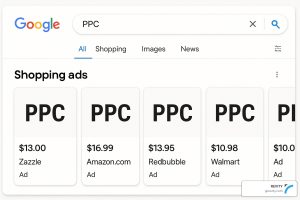Amazon has emerged as a towering presence, paving the way for Amazon marketing and revolutionizing how people shop and businesses operate. What began as an online bookstore has now evolved into an all-encompassing marketplace that offers an unparalleled range of products, from books and electronics to fashion and groceries.
This evolution has been propelled by Amazon’s customer-centric approach, expedited shipping services, and the convenience of shopping from the comfort of one’s home. As a result, the platform has become a bustling hub of economic activity, attracting millions of sellers vying for the attention of an ever-discerning customer base.
The significance of effective marketing on Amazon cannot be overstated. The competition is fierce, the options are abundant, and the window of opportunity to capture a customer’s interest is fleeting.
Standing out requires more than just having a great product. This is where the art and science of Amazon marketing come into play. It’s about understanding the nuances of Amazon’s ecosystem and utilizing them to your advantage.
Putting together an effective strategy to market your products on Amazon involves a multifaceted approach that combines optimization, branding, advertising, and customer engagement.
In this blog, we will delve into a comprehensive guide on how to successfully market your products on Amazon. From optimizing your product listings to navigating Amazon’s advertising console, we’ll cover the strategies and techniques that can set you on the path to success.
So, whether you’re an established seller looking to enhance your presence or a newcomer eager to make a mark, this guide will equip you with the knowledge and tools needed to navigate the intricate realm of marketing on Amazon.
1. Understanding the Amazon Ecosystem
At the heart of Amazon’s success lies a meticulously crafted ecosystem that powers its marketplace. To effectively market your products on Amazon, it’s crucial to understand the intricacies of this ecosystem and how its various components interact. Let’s explore some key elements:
Amazon’s Search Algorithm
Amazon’s search algorithm, often called A9, is the invisible hand that guides customers to the products they seek. It’s driven by a complex set of factors that determine which products appear prominently in search results. These factors include product titles, bullet points, descriptions, backend keywords, and sales history.
Product Rankings
Ranking high in search results is the Holy Grail of Amazon marketing. The products on the first page of search results enjoy significantly higher visibility and, consequently, more clicks and potential sales. Amazon ranks products based on their relevance to the search query and their historical performance in terms of sales and customer satisfaction.
Customer Reviews
In the digital age, customer reviews function as the modern-day word-of-mouth marketing. Positive reviews build trust and credibility, while negative ones deter potential customers. Encouraging genuine customer reviews is essential, as they contribute not only to your product’s reputation but also to its search ranking.
Navigating Amazon’s ecosystem requires alignment with its guidelines to avoid penalties like suppressed listings or account suspension. Amazon prioritizes positive customer experiences, focusing on value delivery, transparent communication, and high-quality offerings.
Understanding and adhering to these principles lets you capitalize on the ecosystem’s dynamics. Optimizing product listings according to A9’s algorithm, fostering positive reviews, and following Amazon’s guidelines enhance visibility and credibility.
2. Conducting In-Depth Market Research
Embarking on a successful Amazon marketing journey requires a solid foundation, and that foundation is built upon thorough market research. This crucial step ensures that you’re not just guessing but making informed decisions based on actual data.
Amazon is a goldmine of insights. Best Sellers show high-demand products, New Releases reveal trends, and Movers & Shakers spotlight rising popularity. Utilize these sections to spot market trends.
Specialized tools like Jungle Scout, Helium 10, and AMZScout amplify research. They offer data on keywords, competition, and sales estimates, aiding informed decisions.
Keywords are crucial. Tools help identify relevant keywords with good search volume and manageable competition, boosting visibility.
Analyze competitors’ listings, images, pricing, and reviews for insights. Adapt your strategy to stand out and provide unique value. Research becomes actionable insights. Identify products, evaluate competition, find keywords, and craft a holistic strategy for listings, branding, and advertising.
In essence, thorough market research is the compass that steers your Amazon marketing ship in the right direction. It’s a step that cannot be rushed or overlooked.

3. Optimizing Product Listings for Discoverability
On Amazon, your product listing is your virtual shelf, and optimizing it is akin to providing clear signage and descriptions. Let’s dive into the details of optimizing your product listings for maximum discoverability:
Compelling Product Titles, Bullet Points, and Descriptions
Crafting a captivating product title is your first chance to grab a shopper’s attention. It should be concise yet descriptive, including key information like product type, brand, and important features. Consider what your potential customers would search for and incorporate those keywords naturally.
Bullet points are your opportunity to highlight key product features, benefits, and unique selling points. Use them to communicate the value your product offers succinctly. Then, in the product description, go more in-depth. Tell a story, address customer pain points, and provide all the information a potential buyer might need to make an informed decision.
Visual Storytelling: Images and A+ Content
High-quality images are virtual touchpoints for customers. Clear, well-lit images showcase your product from various angles and help potential buyers visualize owning it. Professional images not only instill confidence but also convey a sense of quality.
A+ Content (formerly Enhanced Brand Content) takes your product description to the next level. It allows you to include additional images, detailed product information, and even videos. This immersive experience enhances customer engagement and can lead to higher conversion rates.
Backend Keywords: The Hidden Gems
While the visible components of your product listing are critical, don’t overlook the backend keywords. These are hidden keywords that help improve your product’s search visibility. Include synonyms, alternative phrasings, and misspellings that customers might use when searching.
Keep in mind that these keywords aren’t visible to customers, so they don’t need to be as polished as the ones in your visible listing.
Optimizing your product listing creates a seamless buyer journey. Balancing descriptive content and engaging visuals boosts discoverability and shopping experience, enhancing conversions.

4. Leveraging Amazon SEO Strategies
In Amazon’s digital marketplace, the art of being discovered by potential buyers is heavily influenced by a powerful force known as the A9 algorithm. Understanding and leveraging this algorithm is a cornerstone of successful Amazon marketing.
At its core, Amazon is a search engine for products, and A9 is the engine that powers it. Like Google’s search algorithm, A9 determines the order in which products appear in search results. It factors multiple elements, including relevance, performance, and customer behavior. This means that optimizing your product listing for keywords and user experience is essential to outsmarting the algorithm.
Strategic keyword placement is a foundational aspect of on-page SEO. Incorporate relevant keywords naturally into your product title, bullet points, descriptions, and backend keywords. However, avoid keyword stuffing; prioritize readability and conveying value to potential buyers.
Long-tail keywords – longer, more specific phrases – are particularly valuable. While they might have lower search volumes, they often indicate a higher intent to purchase. Incorporating these targeted phrases can attract more qualified traffic to your listing.
A significant portion of Amazon’s traffic comes from mobile users. Ensure your product listing is mobile-friendly, with concise yet informative content and images that load quickly on mobile devices.
A9 considers reviews and feedback, enhancing trust and rankings. Positive reviews emphasize value. Upholding seller reputation with excellent service, precise descriptions, and on-time shipping benefits customers and algorithms.
Mastering Amazon SEO aligns your product with the algorithm’s preferences. Your product appears when buyers search, capturing attention and driving conversions.
5. Creating an Exceptional Brand Presence
Building a brand identity that resonates with customers differentiates your products and establishes trust and loyalty.
Your brand identity is your product’s personality. Start by designing an eye-catching logo that encapsulates your brand’s essence. Your logo should be memorable and instantly recognizable. It’s the visual anchor that customers associate with your products.
Beyond the logo, your brand story is what sets you apart. Why did you create your products? What values do you stand for? How do your products enhance customers’ lives? Communicate your brand story through your product listings and engage customers emotionally.
Consistency is key. Maintain a consistent visual identity across all your product listings, from colors to fonts. This cohesiveness fosters recognition and trust among customers.
Harnessing the Power of Amazon Brand Registry
Amazon’s Brand Registry offers potent benefits. Registration gives control over listings and safeguards intellectual property. Features include infringement monitoring, unique story-driven pages, and EBC for enriched product content.
EBC enhances shopping with visuals, charts, and detailed descriptions. This immersive approach boosts conversions by providing in-depth product information.
Think of Enhanced Brand Content as your product’s digital storefront. It’s an opportunity to go beyond the basic product information and create a branded shopping experience. Utilize high-quality images, engaging videos, and detailed descriptions to showcase the features and benefits of your products.
When customers engage with your product listings on a deeper level, it increases their understanding of your offerings and builds a stronger connection to your brand. The result? More informed purchasing decisions and a higher likelihood of customer satisfaction.

6. Implementing Amazon Advertising Campaigns
Amazon offers a suite of advertising options to help you boost your product’s visibility, attract potential customers, and ultimately drive sales.
Amazon provides several advertising options, each tailored to different goals and strategies:
- Sponsored Products: These ads appear within search results and on product detail pages. They’re triggered by relevant keywords, allowing you to target customers actively searching for products similar to yours.
- Sponsored Brands (formerly Headline Search Ads): These ads showcase your brand logo, a custom headline, and a selection of your products. They create brand awareness and direct customers to a custom landing page or your Amazon Store.
- Product Display Ads: These ads appear on product detail pages, related product detail pages, and even the customer review section. They’re valuable for targeting specific products or categories and reaching customers interested in products similar to yours.
Successful Amazon advertising hinges on precise targeting. Identify relevant keywords from earlier research. Create distinct campaigns for products, customizing ad copy and keywords for relevance.
Leverage Amazon’s varied targeting: keywords, product interests, categories, and specific items. Experiment for optimal resonance with your audience.
Monitoring and Optimizing for Better ROI
A campaign’ launch isn’t the finish line. Monitor performance through Amazon’s metrics, revealing click-driving keywords, conversions, and sales. Refine campaigns based on data. Pause underperforming keywords or products and boost successful ones. A/B testing hones ad copy and strategies.
Amazon advertising is dynamic. Adapt to trends, customer behavior, and rivals for a competitive edge. Stay agile for sustained success.
Whether you’re aiming to boost brand visibility, drive conversions, or simply increase sales, Amazon advertising provides a versatile toolkit to achieve your goals.

7. Building Social Proof through Reviews
Customer reviews are the modern-day equivalent of word-of-mouth recommendations. They provide valuable insights into a product’s pros and cons, helping potential buyers make informed decisions.
Positive reviews contribute to your product’s credibility and enhance its appeal. On the other hand, negative reviews, if handled well, can showcase your commitment to customer satisfaction.
Customers often turn to reviews to gauge the real-world performance of a product. A higher number of positive reviews, especially if they’re recent and relevant, can sway purchase decisions in your favor.
Building a foundation of authentic customer reviews is essential, but how can you encourage them without running afoul of Amazon’s policies? Here are some strategies:
- Deliver Outstanding Products and Service: The first step to getting positive reviews is to offer a top-notch product that meets or exceeds customer expectations. Excellent customer service can also leave a lasting impression.
- Follow Up with Post-Purchase Emails: Reach out to customers after they’ve received their orders. Politely ask for feedback and reviews, emphasizing your desire to provide the best possible experience.
- Provide Clear Instructions: Include instructions on how to leave a review in your packaging or order confirmation emails. Make it easy for customers to navigate the process.
- Engage with Customers: Respond to customer inquiries and concerns promptly. A positive interaction can lead to a positive review.
Addressing Negative Reviews: Turning Challenges into Opportunities
Negative reviews are growth opportunities. Respond constructively, showing dedication to satisfaction. Apologize if needed and offer solutions, displaying care to potential buyers. Perfection isn’t essential; authenticity is. Negative feedback guides improvements. This proactive stance leads to better long-term reviews.

8. Winning the Buy Box
The Buy Box is the coveted “Add to Cart” button on a product listing page. When a customer decides to buy a product, clicking the Buy Box streamlines the purchase process. Winning the Buy Box means your product is the one that customers purchase directly with a single click, bypassing the hassle of comparing multiple sellers.
It’s no exaggeration to say that the Buy Box can significantly boost your sales. Products featured in the Buy Box tend to enjoy higher visibility, greater customer trust, and, consequently, more conversions.
The algorithm that determines Buy Box eligibility takes numerous factors into account. While Amazon’s algorithm is intricate and ever-evolving, some key factors include:
- Price: Competitive pricing is crucial. If your product is significantly more expensive than similar offerings, your chances of winning the Buy Box diminish.
- Shipping: Fast, reliable shipping is highly valued. Amazon Prime eligibility can be a significant advantage, as Prime members expect expedited shipping.
- Seller Performance: Maintaining a stellar track record regarding order defect rate, cancellation rate, and overall customer satisfaction is vital.
- Fulfillment Method: Whether you’re using Amazon’s Fulfillment by Amazon (FBA) or fulfilling orders yourself, the efficiency and accuracy of your fulfillment process impact Buy Box eligibility.
Competitive pricing is vital for the Buy Box. Extreme undercutting isn’t ideal, as it affects profit and quality perception. A balanced approach considering market dynamics, costs, and profit margin is wise.
FBA enhances Buy Box chances, offering Prime benefits. Amazon’s shipping and service reliability boosts trust, elevating product appeal.
Monitor performance metrics and adjust strategies. Invest in top-notch service, prompt issue resolution, and efficient order management for a positive seller rating and customer satisfaction.

9. Navigating Amazon’s Advertising Console
Effective navigation of Amazon’s Seller Central and Vendor Central is essential for success. These control centers serve as your command hub, allowing you to manage everything from product listings to customer interactions.
Utilizing Seller Central and Vendor Central
Seller Central: This platform is designed for third-party sellers, giving you control over your listings, pricing, and fulfillment options. You can create and manage product listings, monitor inventory levels, and engage with customers directly.
Vendor Central: Reserved for manufacturers and wholesale distributors invited by Amazon, Vendor Central offers more direct interaction with Amazon. You can sell products to Amazon in bulk, giving Amazon the authority to set prices and manage listings.
Maintaining optimal inventory levels is crucial to prevent stockouts and ensure smooth operations. Leverage Amazon’s tools to track inventory, set up alerts for low stock, and plan for restocking. Over time, analyzing sales patterns can help you fine-tune your inventory management strategy.
Promptly responding to customer inquiries is a hallmark of excellent customer service. Monitor messages through the Seller Central Messaging Center and address concerns or questions promptly. Timely and helpful responses can foster positive customer relationships and enhance your seller reputation.
Efficiently handling orders is the backbone of a successful Amazon business. Set up order processing notifications to ensure timely shipping — leverage Amazon’s order management tools to streamline the fulfillment process and maintain a reliable track record.
Regularly review your sales performance, seller metrics, and customer feedback. Identify areas for improvement and implement necessary changes. Monitor your return rates and address any recurring issues affecting customer satisfaction.
Adhering to Amazon’s policies is paramount to maintaining a healthy business relationship. Stay updated with Amazon’s guidelines and make sure your product listings, pricing, and interactions align with their requirements. This not only ensures a smooth experience for customers but also safeguards your seller account.
Mastering Seller Central and Vendor Central means equipping yourself with the tools to effectively manage your Amazon operations.

10. Monitoring, Analyzing, and Adapting
Staying ahead of the curve requires more than just initial planning and implementation. It demands a commitment to continuous improvement through data-driven decision-making.
The Power of Data-Driven Decision-Making
Gone are the days of relying solely on gut feelings. In the digital age, data is the compass that guides successful businesses. When it comes to Amazon marketing, making decisions based on actual data rather than assumptions can be the difference between stagnation and growth.
Amazon provides various analytics tools that offer valuable insights into your product’s performance. Amazon’s Sales Dashboard gives you an overview of your sales data, including units sold, revenue generated, and more.
The Advertising Dashboard provides insights into the performance of your advertising campaigns.
Key performance metrics illuminate the health of your Amazon presence. Metrics to monitor include:
- Conversion Rate: The percentage of visitors who make a purchase. A higher conversion rate indicates effective product listings and marketing efforts.
- Click-Through Rate (CTR): The percentage of people who click on your product listing after seeing it in search results. A high CTR indicates that your product is relevant to the search query.
- Return Rate: The percentage of customers who return your product. A high return rate could indicate issues with product quality or listing accuracy.
Regularly reviewing your performance metrics enables you to identify patterns and trends. Are there specific products that consistently perform well? Are certain advertising campaigns driving higher click-through rates? Are there products with higher return rates that need improvement?
Based on your data analysis, make informed adjustments to your strategies. This could involve refining your product listings, tweaking your advertising campaigns, or exploring new product opportunities.
Customer feedback is a goldmine of insights. Positive feedback tells you what you’re doing right, while negative feedback highlights areas for improvement. Consider customer feedback a roadmap to enhancing your products and customer experience.
Market trends are constantly shifting. Stay attuned to changes in customer preferences, industry innovations, and seasonal fluctuations. Your ability to adapt your strategies to align with these trends can give you a competitive advantage.
11. Expanding Your Reach Beyond Amazon
While Amazon provides a powerful platform for showcasing and selling your products, it’s important to remember that it’s just one piece of the e-commerce puzzle. To truly maximize your success, it’s beneficial to explore avenues that extend beyond Amazon’s borders.
Let’s dive into the strategies for expanding your reach and building a more comprehensive online presence:
Driving Traffic from External Sources
- Leveraging Social Media: Social media platforms offer direct communication with your target audience. Create engaging content, showcase your products, and interact with followers. Paid advertising on platforms like Facebook and Instagram can help you reach specific demographics.
- Influencer Collaborations: Partnering with influencers who align with your brand can introduce your products to new audiences. Influencers can provide authentic reviews and recommendations that resonate with their followers.
- Content Marketing: Creating valuable content related to your products can attract organic traffic. Blog posts, how-to guides, and informative videos showcase your expertise and drive visitors to your website.
- Email Marketing: Building an email list lets you directly engage with potential and existing customers. Send out newsletters, promotions, and product updates to keep your audience engaged and informed.
Benefits of Building an Independent E-Commerce Presence
While Amazon is undeniably a massive marketplace, building an independent e-commerce presence alongside it offers several advantages:
- Brand Ownership: On your independent website, you have full control over branding, design, and user experience. This allows you to establish a unique identity that resonates with your audience.
- Diversification: Relying solely on Amazon can be risky. Diversifying your sales channels reduces dependence on a single platform and insulates your business from sudden changes in Amazon’s policies.
- Customer Data: Building an independent e-commerce presence allows you to collect customer data and insights that inform your marketing strategies and product development.
- Direct Relationships: An independent website fosters direct relationships with customers. This personal connection can lead to repeat purchases and foster brand loyalty.
- Flexibility in Marketing: While Amazon offers advertising options, an independent website gives you more flexibility in creating and managing your marketing campaigns, promotions, and sales events.
Building an independent e-commerce presence complements your Amazon efforts and empowers you to control your brand’s destiny.
12. Staying Updated with Amazon’s Policies
As you navigate the intricate world of Amazon marketing, one constant truth remains: change is inevitable. Amazon’s policies and guidelines are ever-evolving, and staying informed about these changes is vital to maintaining a successful and compliant presence on the platform.
Amazon is a dynamic marketplace that constantly adapts to meet the needs of its customers and sellers.
This means that policies, rules, and guidelines can shift over time. Whether it’s updates to product listing requirements, changes in review guidelines, or alterations to advertising regulations, staying informed is paramount.
Strategies to Ensure Compliance
- Regular Check-Ins: Make it a habit to regularly visit Amazon’s Seller Central or Vendor Central dashboard to check for updates. Amazon often communicates policy changes through these platforms.
- Read Official Communications: Pay close attention to emails and notifications from Amazon. They often contain important updates and information regarding policy changes.
- Educational Resources: Amazon provides webinars, videos, and articles detailing policy changes and best practices. These resources can be invaluable for understanding new guidelines.
- Professional Advisors: If you’re managing a substantial Amazon business, consider consulting legal or e-commerce professionals who specialize in Amazon’s policies. Their expertise can help you navigate complex changes effectively.
Adhering to Amazon’s policies isn’t just about avoiding penalties; it’s about building a sustainable, long-term business. Non-compliance can result in account suspension, loss of Buy Box eligibility, and even legal action. Conversely, abiding by Amazon’s rules fosters customer trust and positions you as a reliable seller.
Remember that adapting your strategies to comply with Amazon’s policies doesn’t mean you’re limited creatively. You can still employ innovative marketing techniques, provide excellent customer service, and stand out in a competitive market while staying compliant.
Ready to Rise on Amazon? Partner with Revity Marketing!
Are you eager to excel at marketing your products on Amazon? Join hands with Revity Marketing now! We’re here to leverage Amazon’s platform, propelling your brand to new heights and surpassing your sales targets.
Connect with us today at 801-877-0608 or via our online form. Let’s embark on your journey to Amazon success together!
































